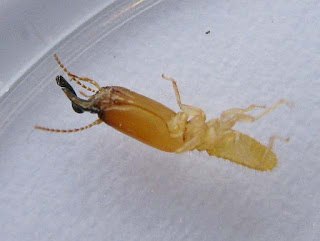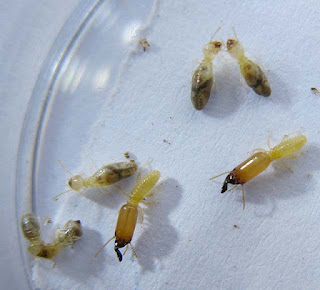Pericapritermes is a mostly humus eating genus of termites. There are however species in this genus that additionally directly feeds on wood. Most humus eating species nest underground but among the humus/wood eating species some build nest with excrement lined walls that the larvae (or nymphs) appear to feed on. The Pericapritermes genus is the most abundance of all the humus eating genus in this region and species are found throughout this region.
Termites soldiers deployed various type of mandible designs to ward off ants their main enemies. The Prricapritermes soldiers used a flicking defense in which the mandibles do not snap shut on their attackers but flick them away much like we use our thumb and index fingers to flick small objects such as a carom's pluck. This defensive strategy is not unique to the Pericapritermes species but it is this species that the mandibles have been most eloquently designed to this specification. Some other genus that uses this same defense are Capritermes,
Dicuspdiitermes,
Procapritermes,
Kemneritermes,
Termes, etc all from the Termes group under the Termitinae subfamily.
The most common predators of termites are ants. Many species of ants, especially forest dwelling subterranean ants have termites as one of its main diet. For this reason most termites mandibles are design to combat ants. While termites with biting or snapping mandibles do not necessarily testified to this definitively, those with flicking mandibles defense which are mostly ineffective outside of the nest tunnels is the classic evolutionary answer to within tunnel defense against foe of more or less similar size in community and eusocial insects. The abundance of termites species that used this flicking defense is conclusive proof that termites defensive strategy are designed specifically to counter their most common predator, ants. This is especially true of humus eating species that are mostly fully subterranean foragers.
The soldiers of this Pericapritermes species have a disperportionately large and long head to body ratio and is extremely clumpsy on smooth surfaces outside of its tunnel passages and earth/excrement nest. The overall shape of Pericapritermes soldiers resembles a small narrow tube ideal to keeping the tunnel passages small and narrow so that the soldiers with their flicking mandibles and head can block it effectively from intruders. Also for this reason their nursery cravens are dispersed, connected by narrow tunnels.
The nest is sometimes found on small raised mounds of earth often at the base of a tree or thereabouts. The internal of the nest proper (where the nymphs are found) is lined by a black lining of probably excrement that serves as food for the larvae (nymphs).
Pericapritermes release nuptials usually after a few days of heavy rain to signal the beginning of the rainy season. The swarms are commonly released during the day when the rain is more or less rain out and slowing to a drizzle. The drizzling rain serves also to minimize predation on the termites coming out to swarm preceded by a large group of workers and some soldiers. Swarms are released based on rainfall and not a definite period of the twenty four hours day. Above evening release of nuptial being targeted by Odontomachus ants.
Nest of Pericapritermes.
Founding reproductive pair with the beginning brood. In most termites fully claustral species, the first two larvae or nymphs to develop into adult individual in a founding colony are always a worker followed by a soldier, then followed by more workers. A second soldier normally do not appear until another month or more later. Soldiers are more costly to raise than workers but they are crucial to nest defense and the strategic success chances for founding nests.

A termite soldier of Pericapritermes sp.
A termite soldier of Pericapritermes sp.
The unique mandibles of Pericapritermes uses a flicking action against intruders to its nest. The force of the flick is powerful enough to decapitate small ants that breech into its tunnel. This flicking action may also propel the soldier in the same way as many Odontomachus ants use their trapjaw to cataput themselves, though in termites this is not likely the intent.
Soldier of Pericapritermes sp.
Soldier of Pericapritermes sp. The tip of the mandibles to the tip of the abdomen measuring over 6 mm.
It is quite common for termites species to have what I called 'slippery feet'. These limbs are not able to grip onto smooth surfaces such as glass and plastics. Some ants genus too are also similarly handicapped.
Pericapritermes sp4.
Worker and a soldier of Pericapritermes sp.
Workers and a soldier of Pericapritermes sp.
Workers and soldiers of Pericapritermes sp.
Workers and soldiers of Pericapritermes sp.
Workers and soldiers of Pericapritermes sp.
Workers and soldiers of Pericapritermes sp.
Imago, workers and soldiers of Pericapritermes sp.
Similar to most termties species Pericapritermes sp. workers are near totally defendless against predators.
Pericapritermes sp3.
Soldier and worker of a large Pericapritermes species. The soldier of this species measured over 7.5 millimeters.
Soldier and worker of a large Pericapritermes species.
See also:
Taxonomy
Domain - Eukaryota
Kingdom - Animalia
Subkingdom - Bilateria
Branch - Protostomia
Infrakingdom - Ecdysozoa
Superphylum - Panarthropoda
Phylum - Arthropoda
Subphylum - Mandibulata
Infraphylum - Atelocerata
Superclass - Panhexapoda
Epiclass: Hexapoda
Class - Insecta
Subclass - Dicondylia
Infraclass - Pterygota
Superorder - Dictyoptera
Order - Isoptera
Family - Termitidae
Subfamily - Termitinae
Tribe - Termitini
Genus - Pericapritermes
Last Updated: 2015 11 03
First Posted: 2009 10 22
© 2009 – 2015 Quah. All rights reserved.





















Amazing pics! have you ever tried raising these guys
ReplyDeletesee third photo
DeleteSo these species is fully claustral? when do they start eating soil?
DeleteThe term semi and fully claustral actually do not applies with termites as all termites are fully claustral, they all seal themselves in their founding chambers. But I know what you mean.
DeleteThe founding pair do not need to eat until the workers start bringing back food to them. This normally happens when the workers starts foraging usually late into the third month.